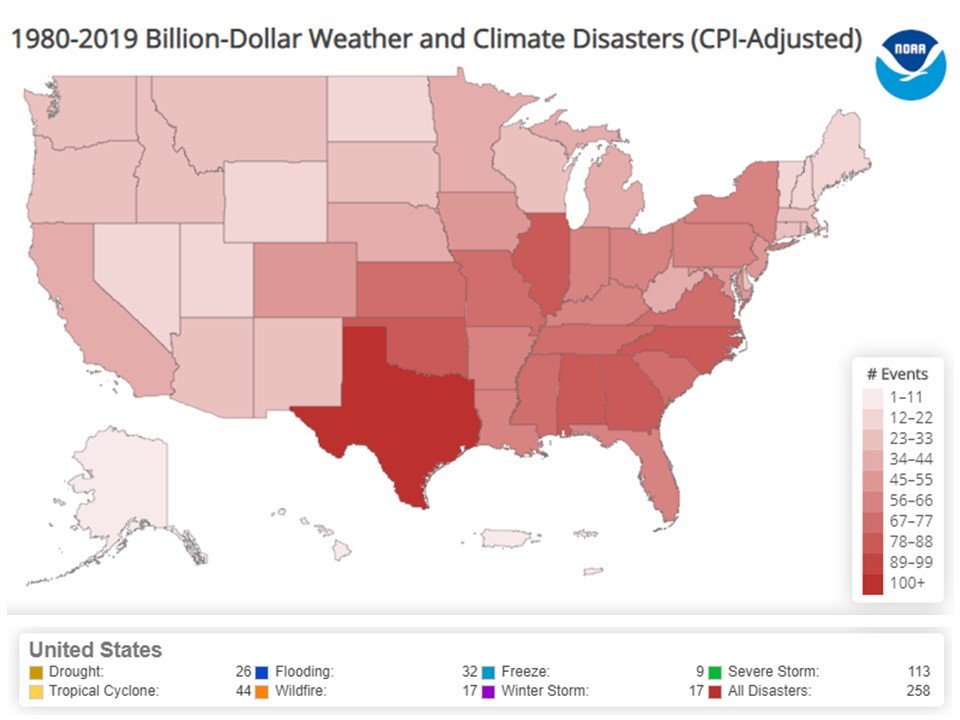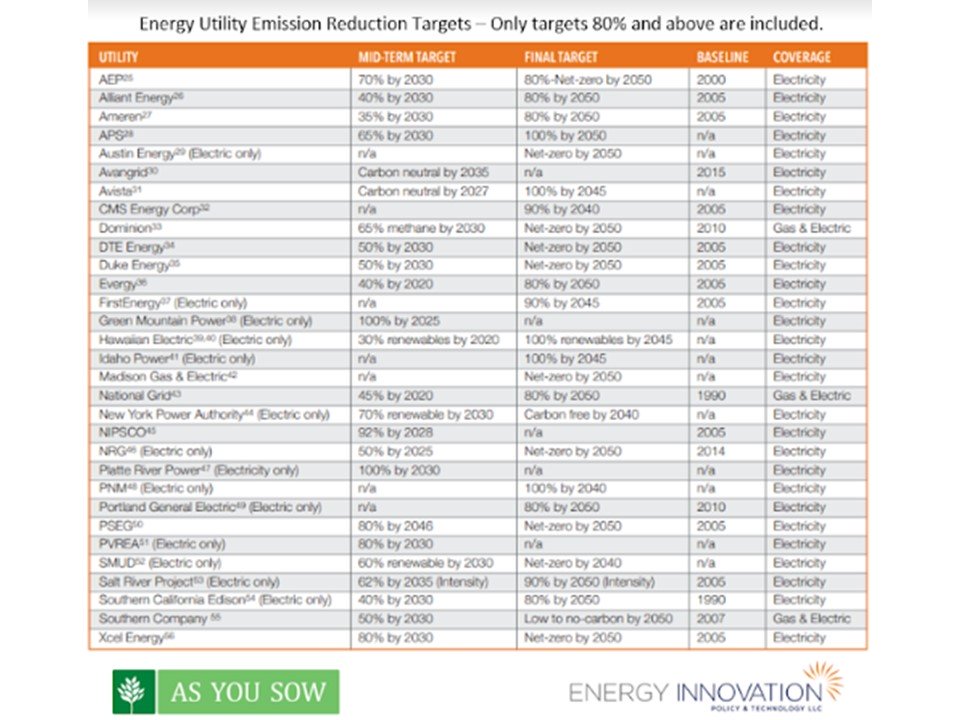Financial market data shows utilities that address risks associated with the changing climate see significant benefits, and utilities that do not lose market value.
Analyses from BlackRock, Morgan Stanley and others reflect what the world is learning in the COVID-19 fight: Aggressive action proactively addressing systemic risk produces better outcomes than pretending there is little risk. For utilities, the data shows that addressing climate-related risks with system hardening and emissions reductions attracts investors and shifts stock valuations, while relying on business as usual discourages investors and increases stock price volatility.
“The evidence on climate risk is compelling investors to reassess core assumptions about modern finance” because they see that “climate risk is investment risk,” CEO Larry Fink of BlackRock, the world’s biggest asset manager, wrote in January. Companies that do not respond to climate change will face “growing skepticism from the markets” and “a higher cost of capital,” but companies that respond will attract “higher-quality, more patient capital.”
Many analysts say utilities that have set climate risk-related goals also remain dangerously invested in fossil assets. Studies show market valuations increase when utilities strengthen their physical systems and begin transitioning to renewables.
The cost-effectiveness of addressing climate risk remains uncertain because the climate is changing so much and so fast that historical weather data does not necessarily reflect new realities. But investors are making their concerns clear.
Analysts sound the alarm
As a result of a “profound reassessment of risk and asset values” in a changing climate, “there will be a significant reallocation of capital by investors,” Fink wrote in his annual letter to CEOs in January.
Climate’s “physical risk” was detailed in an April 2019 BlackRock-Rhodium Group white paper of impacts on the infrastructure of 269 investor-owned utilities (IOUs) from 233 extreme weather events since 1980 that each caused more than $1 billion in damages.
Electric utilities with “exposure to extreme weather events” typically suffer temporary, as much as 6%, stock price volatility shocks “in the wake of natural disasters,” the white paper concluded.
The utilities studied were not named, but “most climate-resilient utilities trade at a premium” that could be as much as 1.5%, and price-to-book ratios showed “similar results.” That premium could increase as “risks compound and investors pay greater attention to the dangers,” the paper added.
“Investors perceive climate change to be happening today,” BlackRock Head of Global Sustainable Research and Data and study co-author Andre Bertolotti told Utility Dive. “The impacts are being measured and investors want to know what they are.”
“Traditional models based on historical data are underestimating the potential impacts of extreme weather because a category three hurricane is now likely to be a category four hurricane.”
Andre Bertolotti
Head of Global Sustainable Research, BlackRock
The “transition risks” from climate change come from a myriad of factors associated with transitioning to clean energy, a separate April 2019 Rhodium Group paper reported. Physical risks come from chronic or sudden extreme weather events that impact infrastructure. But today’s models of physical risk “significantly underestimate actual risk,” it added.
That is because climate change is accelerating and “extreme weather events are more severe, more frequent, and last longer,” BlackRock’s Bertolotti said. “Traditional models based on historical data are underestimating the potential impacts of extreme weather because a category three hurricane is now likely to be a category four hurricane.”
BlackRock is not the only financial powerhouse now recognizing the connection between climate risk and market value.
Investment banking giant Morgan Stanley has also found opportunities in addressing risk.
“Carbon-heavy utilities” can “accelerate their earnings growth” by “shutting down expensive coal plants and investing in cheap renewables,” S&P Global reported Dec. 20, 2019, on findings from a Morgan Stanley Dec. 10 research report.
There is “a double-digit earnings accretion for more than a dozen utilities that decide to retire uneconomic coal plants and replace them with cheaper renewables by 2025,” S&P Global added on Feb. 18, citing another Morgan Stanley study.
The numbers reflect the risks, but also show utilities are not responding wholeheartedly to the threat.

Numbers broaden the story
Based on data from ten large IOUs in hurricane-prone areas, “a typical utility saw $1.4 billion in storm-damage costs and lost revenues due to outages caused by storms” over a 20-year study period, global consultant McKinsey and Co. reported in April 2019. By 2050, that number is likely to grow an estimated $300 million more, to $1.7 billion in economic damage for the average large IOU.
But that typical utility would require only an estimated $700 million to $1 billion to prepare for impacts related to climate change, which is “much less than the projected future storm costs of $1.7 billion,” it concluded. “There are also likely to be ancillary benefits, such as improved reliability and enhanced diversity of supply.”
U.S. electric utilities are, however, “rapidly expanding” investment in fossil fuel infrastructure, according to March 2020 research by Energy Innovation and As You Sow. “Billions of dollars are poised for investment to build natural gas infrastructure” and “the U.S. is on track to spend roughly $1 trillion on new gas-fired power plants and fuel by 2030.”
“The brutal fact is that investors are starting to realize that value in the future will be in companies that are part of the transformation. That means leading on the climate-related risk facing customers.”
Mary Powell
Former CEO, Green Mountain Power
Many IOUs seem to be having it both ways, the researchers reported. They are “setting ambitious, long-term decarbonization targets,” but “many of the same IOUs continued investment in new natural gas infrastructure.”
An investor response has started. Climate Action 100+, a global investor coalition with over $41 trillion in assets, is pushing its 161 companies across all sectors to align their actions with the goals of the Paris Climate Agreement, the report said. And The Climate Majority Project, representing investors with $1.8 trillion in assets, called for the top 20 U.S. IOUs to target net-zero emissions by 2050.
For now, though, only 11 of the 22 highest greenhouse gas (GHG) emitting electric utilities “plan to slow down their rates of decarbonization over the 2017-2030 time period,” according to a June 2019 analysis from the Energy and Policy Institute. Six “plan to accelerate their decarbonization” and five “did not set any decarbonization targets at or near 2030.”
Utilities queried by Utility Dive offered a range of responses.

The right stuff?
“Utilities are asset-heavy businesses that must maintain extensive and expensive infrastructures,” McKinsey observed. Those assets and the utilities that own them “will be vulnerable” if IOUs don’t prepare by considering climate related risk in both “long-term investments” and “daily operations.”
Xcel Energy has led U.S. IOUs in targeting emissions reductions, reduced its carbon 44% from 2005 levels, and is committed to delivering “100% carbon-free electricity by 2050,” Xcel Energy spokesperson Julie Borgen emailed Utility Dive.
Xcel recognizes climate change as “the most significant environmental, social and governance risk for our industry,” Borgen said. Current planning, which includes “carbon proxy prices and carbon externality values” in least-cost valuations, calls for retiring “approximately half” its coal by 2027 and adding over 4,700 MW of new wind by the end of 2021.
“Climate change is real, it’s happening now, and addressing the challenges it creates is an urgent imperative,” Portland General Electric (PGE) spokesperson Steven Corson agreed. PGE is increasing its zero-emissions resources to achieve its 80% by 2050 emissions reduction goal and investing in system hardening and increased system visibility and flexibility, Corson emailed Utility Dive..
Direct physical risks have not caused harm to PGE’s business but are being addressed in current assessments and will be incorporated into planning, he added. Transition risks have been reduced because renewables and energy storage costs “continue to drop” and are expected “to yield significant benefits for our customers.”
Other IOUs’ plans are constrained by regulatory dictates.
“Risks associated with a changing climate are reflected primarily though our resource planning and decision-making processes,” PacifiCorp spokesperson Bob Gravely emailed Utility Dive. Planning includes demand, supply, and market price data “which contain elements of impacts from a changing climate.”
Pacific Gas and Electric “was essentially best in class in both physical risk and adapting its resource portfolio to transition risk, but became the first climate change-caused utility bankruptcy.”

Emilie Mazzacurati
Founder/CEO, Four Twenty Seven
PacifiCorp’s current long-term plan includes “billions of dollars” for new renewables by 2025 “as coal units reach planned retirement dates or come out of service early,” Gravely said. But regulators across PacifiCorp’s six-state territory require “least-cost, least-risk resource portfolios” that “ensure system reliability.” Planning models factor in climate risks but the utility cannot “act strictly on climate risks alone.”
Green Mountain Power (GMP) began applying many of these same strategies “over a decade ago,” former GMP CEO Mary Powell told Utility Dive. “We faced the brutal facts of climate change in 2008” and “by protecting customers from climate-related risks, the utility became part of the solution for climate change” while providing “the stable return investors want.”
And yet Pacific Gas and Electric (PG&E) “was essentially best in class in both physical risk and adapting its resource portfolio to transition risk, but became the first climate change-caused utility bankruptcy,” Emilie Mazzacurati, the Founder/CEO of climate risk economic analysis firm Four Twenty Seven, told Utility Dive.
“That speaks to the challenge of anticipating traumatic but unexpected and abrupt climate change impacts,” Mazzacurati said. “Good risk management is preparing for what is known, but also for possibilities that might seem impossible, or at least highly unlikely. Those risks are now possible because we have set things underway that we can’t stop.”
But there are ways for utilities to approach that type of risk, Rocky Mountain Institute (RMI) analysts said.
Climate aligned portfolios
“Asset managers, analysts, and investors want utilities to address climate-related risks with climate aligned portfolios,” RMI Electricity Practice Managing Director for Emerging Solutions and economist James Newcomb told Utility Dive.
“After today’s crises pass, utilities will see the financial community looking at their portfolios for vulnerabilities to other systemic risks and climate is the most obvious one.”

James Newcomb
Electricity Practice Managing Director for Emerging Solutions, RMI
Working through the global financial system’s Financial Stability Board, some of the leading financial institutions are working to transparently define the climate-aligned portfolio concept for utilities and other companies, Newcomb said. In 2017, they launched the Task Force on Climate-related Financial Disclosures to help companies understand what the financial community wants in a business portfolio aligned with climate risk.
Today’s health and financial crises are global systemic risks that could impact every part of the economy, and climate risks are similarly systemic, Newcomb said. “After today’s crises pass, utilities will see the financial community looking at their portfolios for vulnerabilities to other systemic risks and climate is the most obvious one.”
There is a “significant material risk” for utilities that do not address those vulnerabilities, RMI Electricity Practice Principal Uday Varadarajan told Utility Dive. Access to capital for utilities still relying on coal is already starting to be meaningfully constrained by institutional investors’ focus on climate risk.
But, Varadarajan added, if those utilities address climate-related risks, they can benefit.
The challenge is that utilities are used to certainty and have, for decades, been rewarded for protecting it, GMP’s Powell said. “Now things are happening, hurricanes, wildfires, windstorms, floods, that make it clear the risk of doing nothing is bigger than the risk of doing something to be part of the solution.”
There is still “a lot of traditional thinking,” but there is also an “imperative” to accelerate new approaches, she added. “The brutal fact is that investors are starting to realize that value in the future will be in companies that are part of the transformation. That means leading on the climate-related risk facing customers.”
Correction: BlackRock CEO Larry Fink’s annual letter is to CEOs. An earlier version of this story mischaracterized the correspondence.
Original source: Utility Dive